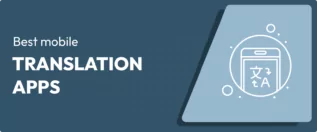
In this post
Multilingual content is a cornerstone of a modern online presentation. Regardless of your exact niche, you’ll need help to reach a global audience. In fact, the same question comes up consistently for many of these businesses: should you hire an in-house translation editor or work with freelancers?
I’ll explore both approaches in detail and help you understand the implications, costs, and considerations for each option. By the end of this guide, you’ll have a clear picture of which path aligns best with your business needs!
Understanding the Role of a Translation Editor
First, it’s crucial to understand what a translation editor actually does. Word-for-word translation tasks are (of course) part of the role. However, the editor ultimately maintains your brand’s voice across languages and ensures cultural relevance and technical accuracy to boot.
There are many other aspects a translation editor will handle:
- They’ll review and refine machine translations for accuracy and cultural context.
- The editor will ensure consistency in terminology and brand voice across all languages.
- If you use content creators or marketing teams, the editor will coordinate with them.
- Likewise, if you keep translation style guides and glossaries, your editor will typically maintain them.
- Your editor will provide quality assurance for all of your translated content.
This broad scope means the role requires someone with both linguistic expertise and project management skills. As such, your translation editor becomes a crucial bridge between your content and international audiences, whether they’re in-house or freelance.
The Case for In-House Translation Editors
Having an in-house translation editor offers several distinct advantages that might make it the right choice for your business. I’m going to explore what makes this option attractive for many organizations.
Deep Brand Integration
Using an in-house editor means you can control the level of immersion they have within your company culture. Over time (and with the right guidance), they should develop an intimate understanding of your brand voice, product nuances, and business objectives. In combination, this deep cultural integration often results in more authentic and consistent translations across your content.
This is something global tech industries work hard to achieve because the leaders of those companies know product knowledge is as crucial as language skills. As such, an in-house editor can work closely with your development team to understand product updates and technical documentation firsthand rather than through briefs.
Immediate Availability
Having a dedicated editor on your team means you have immediate access to translation expertise. This becomes invaluable when you need quick turnarounds on content updates or have questions about cultural appropriateness.
In addition, your translation editor can participate in content planning meetings from the start of their tenure. This ties in with integrating them into your company culture, and will help to shape content that will work well across multiple languages.
Quality Control and Consistency
Because they are in-house, your translation editor can implement and maintain rigorous quality control processes. There are a number of ways to achieve this:
- Building comprehensive style guides for each language you serve.
- Developing translation memories and the associated systems to use it.
- Ensure consistent terminology across all of your content in line with the job’s typical role.
To touch on this final point more, accuracy is paramount. Of course, every business should strive to provide accurate information. For legal or medical content in particular, consistency and quality control can have a huge impact.
The Investment For In-House Translation
An in-house translation editor can be a big plus, but there’s one massive drawback: investment. There are a few aspects to consider here, and I want to quickly cover them before looking at freelance team members.
Salary and Benefits
According to Glassdoor, a translation editor position in the United States typically pays around $60,000 per year. Of course, this depends on a number of factors, such as location, experience, and the industry.
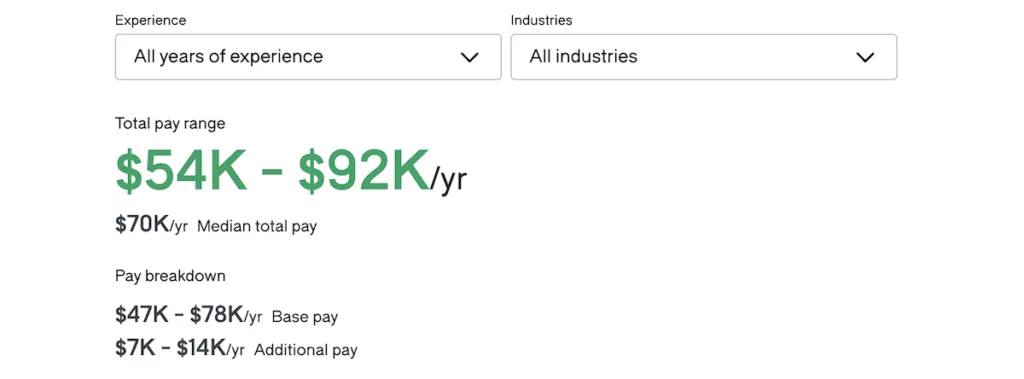
It could be a nearly six-figure investment for your company with a top-tier hire. This is before any additional costs, such as benefits, equipment, performance bonuses, and professional development. Of course, this cost is only for a single translation editor.
Speaking of professional development, an in-house position requires attention in the form of management supervision. You’ll need to provide direction to your editor, conduct performance reviews, and ensure all of the resources they need to succeed are in place. This overhead shouldn’t be underestimated, particularly if translation isn’t a core function of your business.
The Freelance Alternative
Working with freelance translation editors can offer a different set of advantages and considerations than in-house types.
If your business needs flexibility or has varying translation needs, outsourcing the work could be the best option. It’s certainly popular among many businesses. Here’s what I think you need to consider when taking on a freelance translation editor.
Flexibility and Scalability
One massive positive freelancers can give you is the ability to scale your translation efforts up or down based on demand. Your business might have seasonal fluctuations or different needs on a per-project basis. It means you can bring on the right team members for your needs at the time, then cut your costs once that demand is through.
Speaking of which, this scalability is not only for financial concerns. There are plenty of ways you can engage freelance flexibility to help you optimize and target specific tasks for your site. For instance, you can engage different translators for different languages or content types.
I next want to touch on this aspect a little more, and also the cost of taking on freelancers.
Diverse Expertise
The flexibility freelancers give you extends to the pool of knowledge, varied experiences, and unique specializations they bring with them. For example, you can select translators with specific industry knowledge or cultural backgrounds based on your project needs. This diversity can be particularly valuable when you want to enter new markets or handle specialized content.
Consider a situation where you run a few different global locations. Each freelancer could have specific and deep knowledge about the area you assign to them. This can give you an edge where a singular in-house translation editor might not be able to.
Cost-Effectiveness
On the surface, freelance rates can seem higher on an initial basis. As an example, the hourly rate will be higher than an in-house translation editor. However, basing a decision on this facet alone is short-sighted.
While those initial freelance rates might be higher on an hourly basis, you only pay for the work you need. Over time, this can result in significant savings in comparison to a full-time salary, especially if you have a moderate translation volume.
What’s more, freelancer rates can vary based on the need and location of the hire. Even a quick glance at a platform such as Upwork will show a range of hourly rates that depend on quality and language translation:
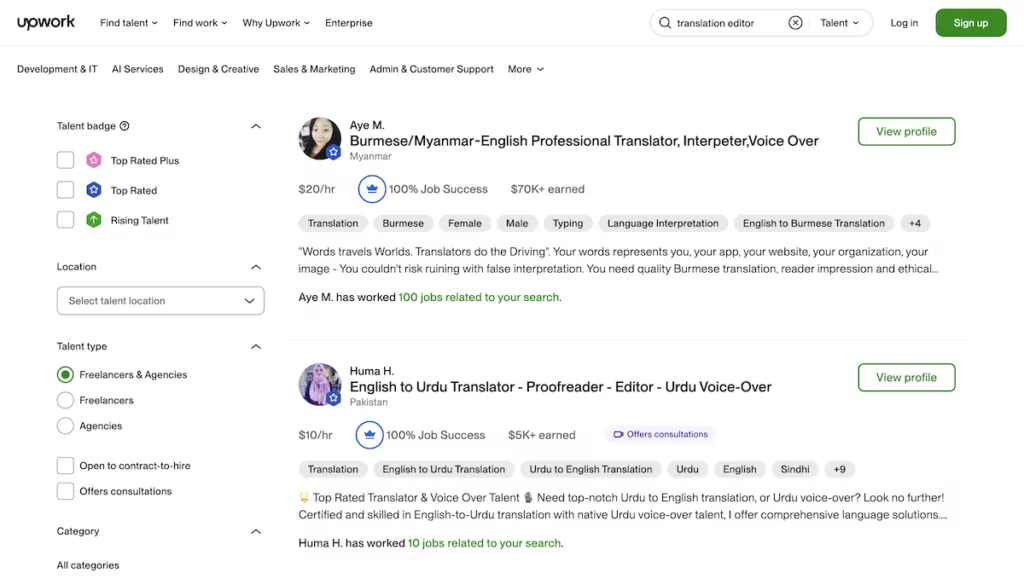
A specialized translation marketplace or other platform might have a different set of rates and editors too. Ultimately, a freelancer can be cheaper, but it does involve more work to hire the right one.
In-House vs Freelance: How to Make the Right Choice for Your Business
In a nutshell, the decision of whether to hire an in-house translation editor or a freelance one will depend on several key factors:
- Content volume and frequency. If you produce large volumes of regular content across multiple languages, an in-house editor might be more cost-effective. However, if you work with translations per project or on an irregular basis, a freelancer could be the better choice.
- Budget considerations. In-house editors need a significant upfront investment to succeed, although they can be more economical if you have a substantial ongoing translation need.
- Technical requirements. For complex, intricate translation needs, an in-house editor who can work closely with your technical team might be an advantage.
Of course, you could also start with a freelancer to test the waters, then hire them as a full-time team member if you require it. However, there’s a third approach that can cover some of the positives of both types of translation editors.
How TranslatePress Can Help Optimize Both Approaches
Regardless of whether you choose in-house or freelance translation editors, technology will play a crucial role in optimizing the process. This is where TranslatePress can become an invaluable tool in your workflow.

TranslatePress offers functionality that complements both in-house and freelance translation approaches. In fact, its automatic translation options serve as a suitable ‘first draft’ for your new hires to work with.
TranslatePress Multilingual
From there, your translation editor can use the visual interface to see exactly how translations will appear on your site:
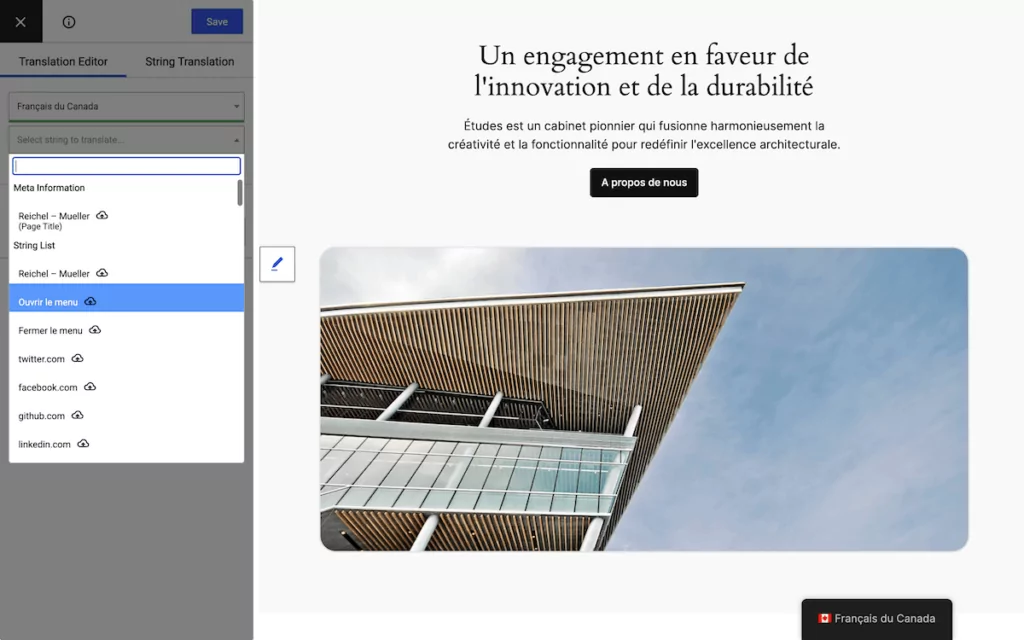
If your translation editor is part of a wider multilingual strategy team, they can also leverage the robust and powerful user role management to organize everyone:
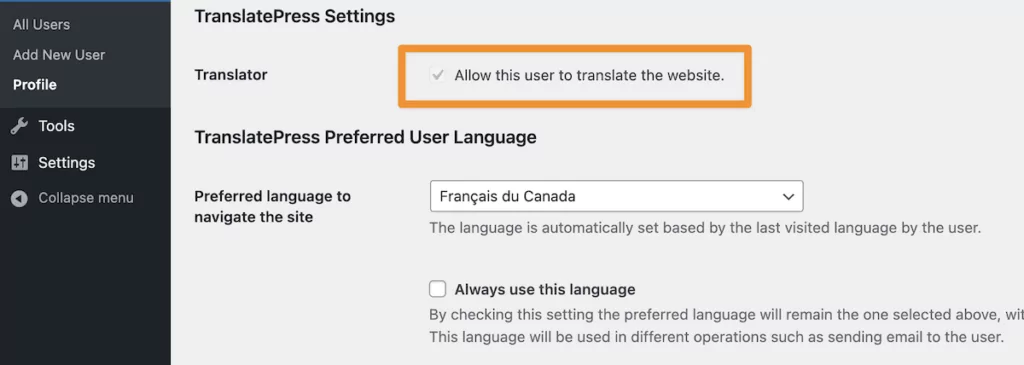
TranslatePress has more to offer any multilingual content strategy, regardless of your chosen staffing approach. Its key strength is how it slots into your workflow where you need it.
How to Implement Your Translation Strategy
So, at this point, you have a decision to make: choose an in-house translation editor or a freelancer. You should have an idea of which one is more suitable for your needs, but the process for onboarding each differs.
For in-house hires, you’ll have more internal work to do, in my opinion. This is because it’s a new permanent addition to the team, which will need you to ‘carve out’ room in your processes for them. There are a few general steps you can follow:
- Define clear job requirements and responsibilities, potentially using a contract or agreement.
- Develop a comprehensive onboarding process if you don’t already have one.
- You’ll need to set up all the necessary tools and systems your hire needs, including TranslatePress.
- If you don’t have documentation for translation processes and standards, this should be in place too.
Note that your new translation editor may have a greater input into creating documentation. This should be clear within the role’s requirements and responsibilities.
For collaborating with freelancers, you still need to define requirements and responsibilities, but at a more shallow level. It’s more important to establish clear project guidelines and expectations, as this will be more impactful.
Your vetting process should be robust, ideally asking for previous experience of the role. The job of creating detailed briefs and style guides will be on you though. This means you can’t expect the freelancer to build onto a set of skeleton guides, which can take some work internally. Setting up efficient communication and file-sharing systems is also part of this step.
Utilizing a Hybrid Approach to Translation
Many successful businesses employ a hybrid approach, which combines a number of translation types and options:
- An in-house translation editor who manages overall strategy and quality control.
- Freelance translators for specific languages or project overflow.
- Solutions such as TranslatePress to streamline workflows and ensure consistency.
This combination often provides the best of both worlds: consistent quality control with the flexibility to scale as needed.
With TranslatePress, you can handle those first, initial content translations alongside other technical tasks (such as adding language switchers and content organization). Overall, TranslatePress can streamline your workflow and help your translation editor get to work faster.
Moving Forward with Your Translation Strategy
The choice between in-house and freelance translation editors isn’t always straightforward, but understanding your specific needs and constraints can guide you to the right decision. Remember that you can always adjust your approach as your business evolves.
Whether you choose an in-house translation editor, someone freelance, or a hybrid approach, implementing the right tools and processes is crucial. TranslatePress can serve as the foundation of your translation workflow as it provides the technical infrastructure you need for success in every scenario.
TranslatePress Multilingual
Which option are you leaning towards: an in-house translation editor or a freelance one? I’d love to hear your thoughts in the comments section below!


